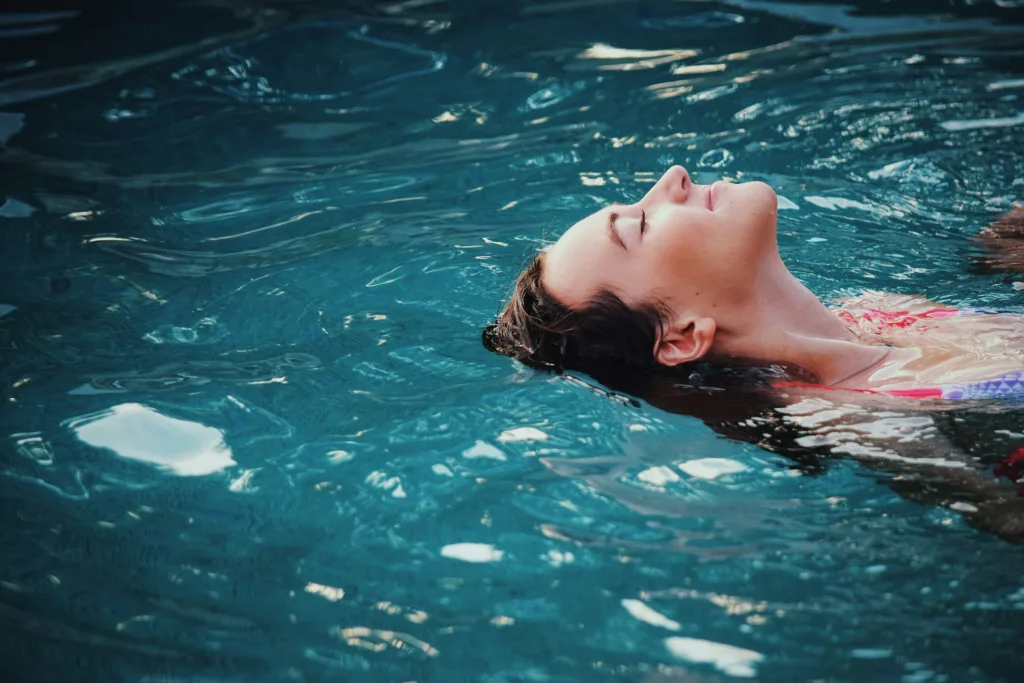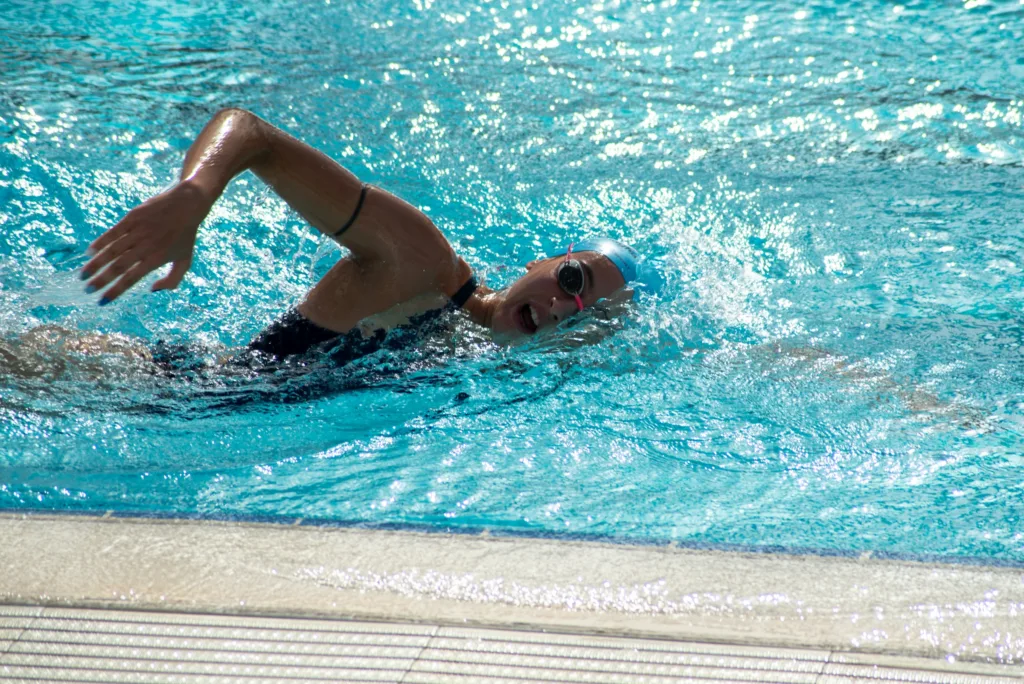Mastering the Water: Swimming for People with Blindness and Low Vision
Swimming is an exceptional low-impact exercise that offers fun, fitness, and relaxation for people of all ages and abilities. The natural buoyancy of the water creates a profoundly safe and therapeutic environment that minimizes anxiety and maximizes physical confidence for individuals with blindness or low vision.
The Unique Health and Safety Benefits of Water-Based Activity
For individuals with vision loss, swimming provides distinct advantages over land-based activities:
• Confidence and Independent Movement: The water eliminates the risk of tripping over obstacles, allowing for free movement and greatly boosting confidence.
• Proprioceptive Feedback: The resistance of the water provides excellent feedback to the muscles and joints (proprioception), helping swimmers with low or no vision better sense their body’s position and movement in space.
• Cardiovascular Health: Swimming offers a full-body, non-weight-bearing workout that significantly improves cardiovascular health, muscular strength, and range of motion without straining joints.
• Sensory Integration: The water’s constant, enveloping pressure can be extremely calming and soothing for individuals who experience sensory processing differences.
Safety First: Planning Your Swim

Like any water activity, swimming requires a thoughtful approach to safety and orientation.
• Secure a Sighted Partner: Swimming with a sighted friend, family member, or trusted companion remains the most effective way to ensure safety and comfort, particularly when in unfamiliar pools or open water. This companion can provide verbal cues, guide you to the edge, and alert staff.
• Communicate with Facility Staff: Always inform the lifeguard, instructor, or pool manager that you have blindness or low vision. This alerts the team to be aware of your location and potential orientation needs.
• Use Your Mobility Aid Strategically: Use your white cane or a sighted guide to navigate the pool deck, locker rooms, and changing areas. These areas can be especially hazardous due to slippery, high-glare tiles, inadequate lighting, or unexpected obstacles such as benches. Designate a specific, safe location to leave your cane once you enter the water.
• Manage Light and Glare: If you have low vision, wearing tinted or colored goggles may be helpful. These aids help manage the severe glare created by sunlight reflecting off water and wet surfaces, while also enhancing contrast to better define pool features, such as steps and lane lines.
• Enroll in Adaptive Lessons: If you are new to swimming, prioritize finding local Adaptive Aquatics or Special Abilities Swim Lessons. These programs, often available through local swim schools, YMCAs, and community centers, specialize in a multi-sensory approach and provide focused, one-on-one instruction tailored specifically to your sensory and mobility needs.
Mastering Navigation: Staying Straight and Turning
The primary functional challenges for swimmers who are blind or have low vision involve maintaining a straight line and accurately judging when to stop or turn at the wall. Fortunately, professionals have developed several highly reliable methods for orientation.
The Role of the Orientation and Mobility (O&M) Specialist
An O&M specialist specializes in helping people with vision loss develop the skills and confidence to travel safely. While they are usually associated with land travel, an O&M specialist can offer invaluable consultation on pool orientation, ensuring you enter and exit the water safely and efficiently.
The Tapper: Your Non-Visual Turn Signal
For both competitive and serious fitness swimming, the tapper is the standardized and most precise method for signaling turns.
• A tapper is a trained person, typically a coach or a designated volunteer, who stands at the end of the pool lane.
• The tapper uses a long pole with a soft foam tip (often a tennis ball or soft sponge) to deliver a gentle, firm tap to the swimmer’s head or back.
• This tap signals the swimmer that they are exactly one arm’s length from the wall, prompting them to execute their flip turn or simply stop safely.
• This high-trust system is indispensable for athletes competing under international rules.
Independent Orientation Strategies
For recreational or fitness swimming, you can rely on the following independent cues:
• Tactile Feedback (Trailing): Many swimmers use this technique by lightly trailing their fingers along the floating lane lines or the pool gutter/side wall. This provides a constant, subtle tactile cue that helps you maintain a straight course without the need for a spotter.
• Stroke Counting: Before a workout, measure the number of strokes it takes you to swim the length of the lane at your typical pace. During your swim, simply count your strokes and begin slowing down on the final two or three strokes.
• Auditory Cues: A trusted friend or coach can stand at the end of the lane and call out your name, use a distinctive auditory signal (like tapping the side of the pool with a bell), or simply use their voice to direct you as you near the wall.
• Utilizing Technology: Smart devices can enhance your water independence. Many swimmers use waterproof smartwatches (like the Apple Watch) to set distance-based alerts, track stroke counts, or utilize timing features. More advanced wearable devices that utilize vibration feedback to signal lane drift or proximity to the wall are continually being developed and tested.
Competitive Para Swimming

Swimming is a cornerstone of the Paralympic Games, offering robust opportunities for athletes who are blind or have low vision at local, national, and international levels.
Para Swimming Classification (S11, S12, S13)
Competitive integrity requires a system of classifying athletes based on their visual acuity. Swimmers are assigned to one of three Para swimming sport classes, based on their vision:
• S11 (B1 Classification): Athletes in this class have total or near-total blindness. They must wear darkened or blacked-out goggles during all competitive events to ensure no advantage is gained from any remaining light perception.
• S12 (B2 Classification): Swimmers have severe visual impairment but retain a greater degree of sight than S11 athletes.
• S13 (B3 Classification): Swimmers have the least severe visual impairment eligible for competition, but still experience a significant disability.
Resources for Aspiring Athletes
If you or a loved one are interested in competitive swimming, consult the following organizations for resources, local club information, and competition schedules:
• U.S. Association of Blind Athletes (USABA): The official source for adaptive sports in the United States, providing pathways to training and competition.
• World Para Swimming (IBSA): The international governing body that sets classification rules and organizes world-class events.
Learning to Swim with Confidence
It is a common myth that individuals who are blind or have low vision cannot learn to swim. This is fundamentally untrue. The environment of the pool is actually one of the safest places to build physical confidence.
When learning, an instructor who uses hands-on teaching—guiding your arm and leg movements—combined with highly descriptive language and tactile feedback, ensures you acquire the correct stroke technique. With consistent practice and professional guidance, you will achieve proficiency, allowing you to move safely, efficiently, and confidently in the water. Swimming restores freedom and independence for people who are blind or have low vision.